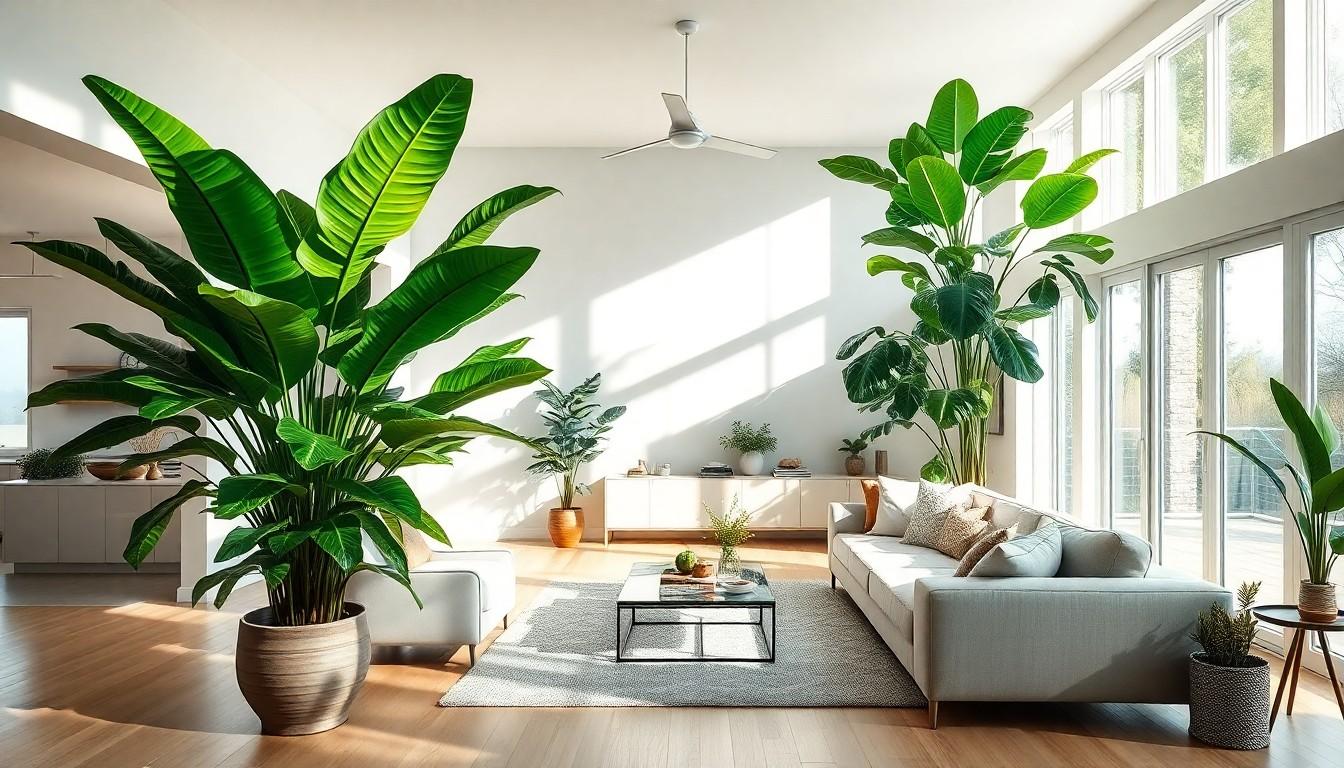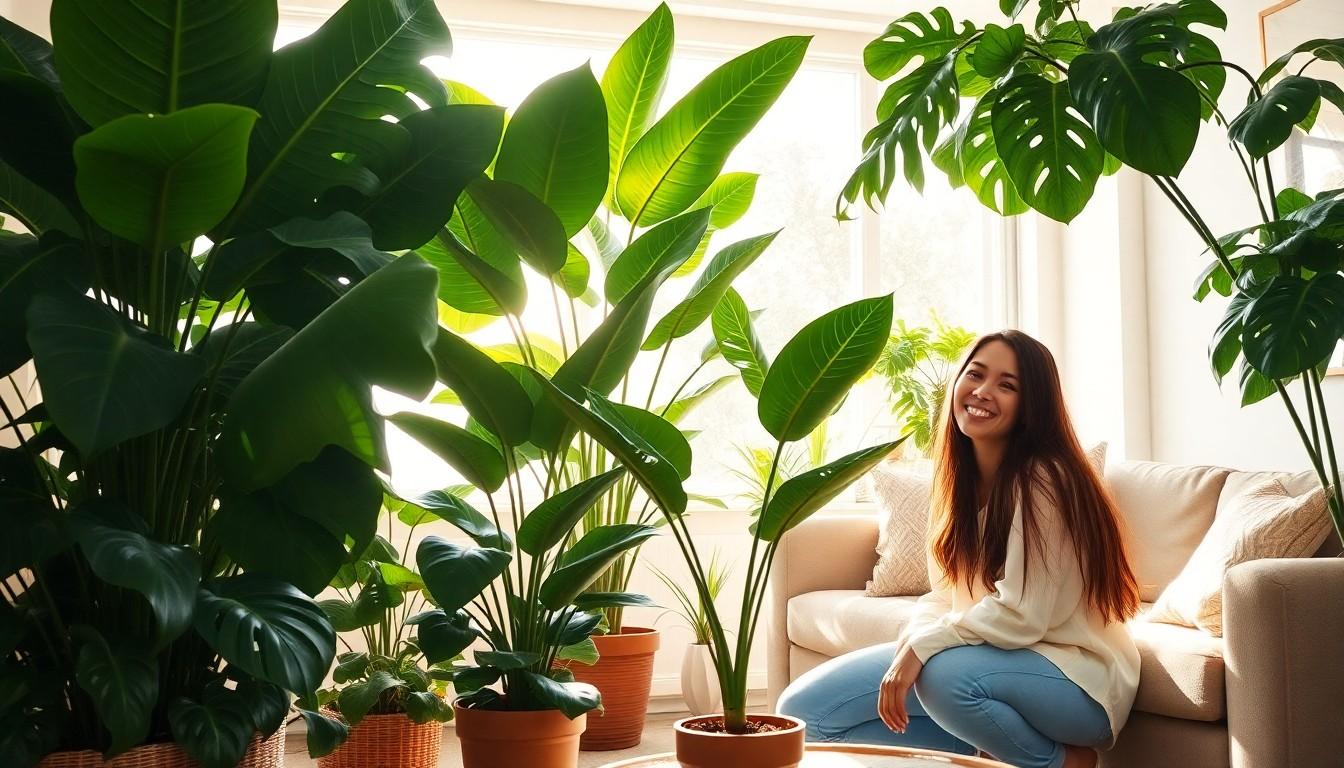Imagine transforming your living space into a lush jungle without the hassle of a passport or a plane ticket. Huge house plants are the secret weapon for anyone looking to add a splash of life and a touch of drama to their home décor. These green giants don’t just sit there; they strut their stuff, making your space feel vibrant and inviting. Plus, they can double as a conversation starter—who wouldn’t want to discuss the merits of a 6-foot-tall fiddle leaf fig?
Overview Of Huge House Plants
Large house plants transform indoor spaces. They enhance aesthetic appeal and improve air quality, providing multiple benefits. Common choices include the rubber plant, fiddle leaf fig, and bird of paradise. Each plant contributes unique characteristics to the environment.
Fiddle leaf figs, known for their dramatic foliage, often reach heights of 6 feet or more. Rubber plants thrive in various lighting conditions, making them adaptable and popular. Bird of paradise plants add a tropical feel with their striking flowers and large leaves.
Care requirements may vary, but most large house plants need ample sunlight and regular watering. Consistent fertilization during growing seasons supports their growth and vitality. Proper potting helps prevent root-bound conditions, crucial for large plants.
Placement plays a vital role in showcasing these plants. Positioning them in well-lit areas ensures they receive adequate light while enhancing room aesthetics. Creating a focal point with a large plant can elevate the overall design of a space.
Sizes can differ considerably. Some plants may grow to over 10 feet indoors, while others remain smaller. When selecting a plant, consider space and maintenance needs to ensure a harmonious fit in the home.
Incorporating these huge house plants can significantly impact indoor ambiance, making them worthwhile additions to any home.
Benefits Of Huge House Plants

Huge house plants provide numerous advantages that enhance indoor environments. These benefits span from improved air quality to striking aesthetic appeal.
Improved Air Quality
Large house plants play a significant role in purifying indoor air. They absorb pollutants like formaldehyde, benzene, and trichloroethylene. Research shows that plants like rubber plants and peace lilies increase oxygen levels and minimize airborne toxins. Increasing the number of house plants correlates with better overall health. Creating a greener environment promotes respiratory well-being and reduces fatigue. By integrating large plants, homeowners can enjoy fresher air while fostering a healthier living space.
Aesthetic Appeal
The visual impact of huge house plants is undeniable. They serve as focal points that draw attention and instill a sense of warmth. Incorporating a lush palm or a tall fiddle leaf fig can transform a dull corner into a vibrant showcase. Each plant type offers unique textures and colors, enhancing overall decor and personal style. Their size adds depth to interiors, making spaces feel more inviting. Creating an engaging atmosphere with large plants also encourages social interaction, making them ideal additions to any home.
Popular Types Of Huge House Plants
Large house plants bring life to any indoor space. Below are popular types that showcase striking beauty and serve practical benefits.
Fiddle Leaf Fig
Fiddle leaf figs stand out with their large, glossy leaves that create an eye-catching focal point. These plants thrive in bright, indirect sunlight, making them ideal for well-lit areas. Regular watering keeps the soil slightly moist, promoting healthy growth. This plant can reach heights of up to 10 feet indoors, making it a bold choice for spacious living areas. In addition, its lush appearance enhances room ambiance while providing a natural touch.
Monstera Deliciosa
Monstera deliciosa, also known as the Swiss cheese plant, showcases distinctive leaves with unique perforations. Adaptable to various light conditions, it prefers bright, indirect sunlight for optimal growth. With proper care, it can grow up to 6 feet tall, bringing a tropical vibe to interiors. Watering requires a careful approach, ensuring the top inch of soil dries out between watering. This plant adds character to any setting, harmonizing well with other decor elements.
Rubber Plant
Rubber plants, renowned for their thick, dark green leaves, add elegance to home spaces. These hardy plants tolerate low light but flourish in bright conditions. An impressive height can reach over 8 feet in suitable environments, making them a striking addition. Consistent watering encourages vigorous growth, while avoiding overwatering is essential to prevent root rot. The rubber plant not only enhances aesthetics but also improves indoor air quality, making it a practical choice for any home.
Care Tips For Huge House Plants
Caring for large house plants involves meeting their specific needs. Understanding light, watering, and fertilization ensure healthy growth.
Light Requirements
Bright, indirect sunlight works best for large house plants. Place them near windows that receive ample light throughout the day. Fiddle leaf figs thrive in 6 hours of filtered light. Monstera deliciosa also benefits from similar light exposure, promoting vibrant foliage. Avoid direct sunlight as it can scorch leaves, leading to damage. Regularly rotate plants to ensure even growth and prevent leaning towards the light source.
Watering Guidelines
Watering needs vary among large house plants. Most require watering once the top inch of soil feels dry. Overwatering can lead to root rot, so checking soil moisture is essential. Use a pot with drainage holes to allow excess water to escape. During growing seasons, increase watering frequency based on temperature and humidity levels. Monitor plants frequently for signs of underwatering, such as wilting or browning leaves.
Fertilizing Needs
Fertilization supports the healthy growth of large house plants. Use a balanced, water-soluble fertilizer every 4-6 weeks during the growing season. This schedule promotes lush foliage and robust root development. Choose a fertilizer high in nitrogen for plants like rubber plants, enhancing their dark, green leaves. Avoid fertilizing during the winter months when plants enter dormancy. Adjust the amount based on the specific plant’s needs for optimal results.
Conclusion
Large house plants bring life and energy to any home. Their impressive size and unique characteristics not only elevate the aesthetic appeal but also promote a healthier living environment. By choosing the right plants and understanding their care requirements, homeowners can create stunning focal points that enhance both decor and well-being.
Incorporating these vibrant greens into living spaces encourages social interaction and transforms ordinary rooms into inviting retreats. With the right placement and care, large house plants can thrive and continue to enrich homes for years to come. Embracing these natural elements is a rewarding journey that leads to a more vibrant and inviting atmosphere.

